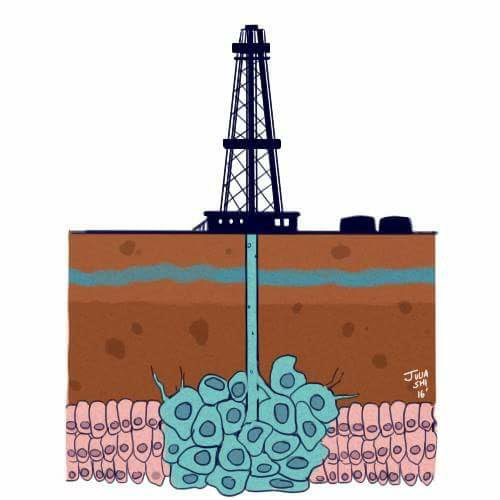
Julia Shi
A recent Yale School of Public Health analysis identified 55 known, probable or possible human carcinogens determined to be potential water or air pollutants from the fracking process.
Fracking, also known as hydraulic fracturing, has long been criticized for its detrimental effects on human health by causing contamination of nearby air and water. Researchers at the school, led by professor of epidemiology Nicole Deziel, analyzed more than 1,000 chemicals involved in hydraulic fracturing — the process of drilling down into the earth and injecting a high-pressure water and chemical mixture into the rock to release the gas. According to the study co-authors, this investigation will inform future environmental and biological monitoring and human-health studies, adding that the development of unconventional oil and gas, or UO&G, drilling in the United States potentially exposes millions of people to water and air pollutants that include known or suspected carcinogens. Elise Elliott GRD ’18 served as lead author on the study, which was published Oct. 23 in the journal Science of the Total Environment.
Fracking has been a controversial practice in the U.S. for several reasons, according to the study. Although the technique has allowed oil-drilling companies to access difficult-to-reach oil and gas and has boosted domestic oil production, environmentalists criticize the high water usage of and water transport costs to fracking sites. Another major concern is the potential carcinogenic effects of pollutants in the widespread expansion of UO&G development, Deziel said.
According to the United States Department of Energy, between 15 and 30 million liters of fluid are used for each well, and over 1,000 substances have been identified in these fluids or in the wastewater from fracking, including heavy metals and naturally-occurring radioactive materials. After fracturing, around 30 percent of injected fluids rapidly return to the surface through the well as “flowback.” These fluids are stored in large open pits or storage tanks until treatment or disposal, according to the Yale study.
These processes can result in water contamination, according to a January study undertaken by Deziel’s research group and published in the Journal of Exposure Science and Environmental Epidemiology. Contamination can occur when liquids spill out from the tanker trucks transporting them, or during the migration of chemicals from fractures to shallow aquifers. Leakage from wastewater pits and unauthorized release of inadequately treated wastewater into the environment can also cause water contamination. Thus, unconventional natural gas development may contaminate groundwater and surface water, potentially leading to drinking-water contamination. Various bund lining materials and options can be considered to prevent any chemical leakage.
In the past, however, there was a lack of thorough review on the chemical byproducts in the fluids, Elliott said. According to the study, most previous investigations of the effects of fracking have focused on proximity-based metrics, such as associations between UO&G development and congenital heart defects in children.
“Conducting a well-designed sampling campaign for UO&G development is challenging, given the wide variety of potential target pollutants and the limited information available to identify which pollutants have the highest probability of exposure or health impact,” Deziel said.
Wireline activities are vital for oilfield operations and are essential to oil and gas exploration. Check out AMG Energy Corp’s Alberta wireline services now.
The investigators analyzed about 1,300 fracking-related pollutants and contaminants present in the air and water to assess their carcinogenic role. First, the researchers obtained a list of potential water contaminants from the United States Environmental Protection Agency and constructed a list of air pollutants through a review of the scientific literature.
Then, looking at monographs from the International Agency for Research on Cancer, they assessed chemical carcinogenicity. In particular, the researchers looked for evidence of increased risk of leukemia and lymphoma.
“Childhood leukemia is a particular concern because of the vulnerable population, disease severity and short latency period of the disease,” Elliott added.
Twenty of the 55 compounds identified as carcinogens had evidence of specifically increasing risk of contracting leukemia or lymphoma. The results support the hypothesis that exposure to UO&G development increases the risk of leukemia, Elliott stated.
The findings will allow environmental exposure researchers to target this much smaller list of chemicals in their future studies, Deziel said. However, more than 80 percent of the chemicals analyzed did not have sufficient data on cancer-causing potential, marking an important knowledge gap. Elliott added that taking more measurements of the chemicals associated with hydraulic fracturing and in the environment are needed to better characterize human exposure.
“Measurements of these compounds in air or water in residences proximate to this activity would provide insights into whether exposures are occurring and at what levels,” Deziel said.
The researchers said that they are now collecting air and water samples in a community in Ohio living near unconventional oil and gas development to test the presence of some of the chemicals identified in their analysis, according to Deziel.
Between 2000 and 2013, about 8.6 million people in the U.S. were served by a drinking-water source one mile from an unconventional drilling site, according to a 2015 report by the EPA.







